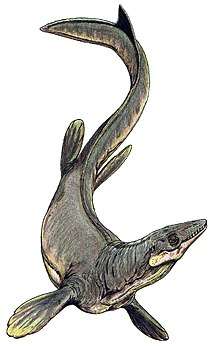Mosasaurini
The Mosasaurini are a tribe of mosasaurine mosasaurs, a diverse group of Late Cretaceous marine squamates. Members of the tribe, known as "mosasaurins", have been recovered from North America, Europe, Africa and Oceania, with questionable occurrences in Asia.[1][2] The tribe contains the closely related genera Mosasaurus, Eremiasaurus, Plotosaurus and Moanasaurus. It has historically been more inclusive, on occasion including genera such as Plesiotylosaurus,[3] Liodon and Clidastes,[4] all of which are now seen as more basal mosasaurines.[5]
| Mosasaurins | |
|---|---|
| Skeleton of Mosasaurus (front view) in the Maastricht Natural History Museum. | |
| Scientific classification | |
| Kingdom: | Animalia |
| Phylum: | Chordata |
| Class: | Reptilia |
| Order: | Squamata |
| Superfamily: | †Mosasauroidea |
| Family: | †Mosasauridae |
| Subfamily: | †Mosasaurinae |
| Tribe: | †Mosasaurini |
| Genera | |
| Synonyms | |
| |
Mosasaurins were highly derived predatory mosasaurs, containing genera like Plotosaurus, with unique adaptations towards fast swimming speeds and Mosasaurus itself, among the largest of the mosasaurs.
The etymology of the tribe derives from the genus Mosasaurus (Latin Mosa = "Meuse river" + Greek sauros = "lizard").
Description

The Mosasaurini are a clade of derived mosasaurine mosasaurs. The tribe contains one of the largest known mosasaur species, Mosasaurus hoffmannii at over 12 meters in length, but it is notable that such a size is unusual within the tribe and even within the genus Mosasaurus itself. Other large mosasaurins are in a size range around 8 meters in length (such as Plotosaurus, Eremiasaurus and Mosasaurus conodon) whilst others are even smaller in a range of about 5–6 meters in length (such as Mosasaurus beaugei and Mosasaurus missouriensis).
Russell (1967) stated that the Mosasaurini are unified by having twelve or less pygal vertebrae and that the radius and ulna are widely separated by a bridge of carpalia on the distal border of the antebrachial foramen.[4] With Plotosaurus being referred to the Mosasaurini, this definition becomes defunct as Plotosaurus has more than twelve pygal vertebrae and its radius and ulna only nearly contacting above the carpalia on the distal border of the antebrachial foramen. Russell thus considered Plotosaurus as being part of its own tribe, the "Plotosaurini" together with the tylosaurine Taniwhasaurus,[4] but this is not supported in modern analyses.
A more recently suggested definition is a branch-based definition diagnosing the Mosasaurini as the most inclusive clade containing Mosasaurus hoffmannii but not Globidens dakotensis.[6]
Species and taxonomy
Mosasaurini
- Mosasaurus
- M. hoffmannii
- M. missouriensis
- M. conodon
- M. lemonnieri
- M. beaugei
- Moanasaurus
- M. mangahouangae
- Eremiasaurus
- E. heterodontus
- Plotosaurus
- P. bennisoni
- P. tuckeri (possibly synonymous with P. bennisoni)
References
- "Fossilworks: Mosasaurini". fossilworks.org. Retrieved 2017-09-22.
- "Fossilworks: Plotosaurini". fossilworks.org. Retrieved 2017-09-22.
- Grigoriev D. V. (2013). "Redescription of Prognathodon lutugini (Squamata, Mosasauridae)". Proceedings of the Zoological Institute RAS. 317 (3): 246–261.
- Russell, Dale. A. (6 November 1967). "Systematics and Morphology of American Mosasaurs" (PDF). Bulletin of the Peabody Museum of Natural History (Yale University).
- Simões, Tiago R.; Vernygora, Oksana; Paparella, Ilaria; Jimenez-Huidobro, Paulina; Caldwell, Michael W. (2017-05-03). "Mosasauroid phylogeny under multiple phylogenetic methods provides new insights on the evolution of aquatic adaptations in the group". PLOS ONE. 12 (5): e0176773. doi:10.1371/journal.pone.0176773. ISSN 1932-6203. PMC 5415187. PMID 28467456.
- Madzia, D.; Cau, A. (2017). "Inferring "weak spots" in phylogenetic trees: application to mosasauroid nomenclature" (PDF). PeerJ. 5: e3782. doi:10.7717/peerj.3782.
